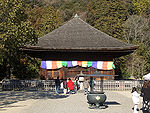
Shiramizu Amidadō
Encyclopedia

Buddhist temples in Japan
Along with Shinto shrines, Buddhist temples are the most numerous, famous, and important religious buildings in Japan.The term "Shinto shrine" is used in opposition to "Buddhist temple" to mirror in English the distinction made in Japanese between Shinto and Buddhist religious structures. In...
in Iwaki
Iwaki, Fukushima
is a city located in the southern part of the Hamadōri coastal region of Fukushima Prefecture, Japan.A designated "core city", Iwaki is also one of the growing number of hiragana cities. Its area is 1,231.35 km², making it the 10th largest city in Japan...
, Fukushima Prefecture
Fukushima Prefecture
is a prefecture of Japan located in the Tōhoku region on the island of Honshu. The capital is the city of Fukushima.-History:Until the Meiji Restoration, the area of Fukushima prefecture was known as Mutsu Province....
, Japan
Japan
Japan is an island nation in East Asia. Located in the Pacific Ocean, it lies to the east of the Sea of Japan, China, North Korea, South Korea and Russia, stretching from the Sea of Okhotsk in the north to the East China Sea and Taiwan in the south...
. The Amidadō is a National Treasure
National treasures of Japan
National Treasures are the most precious of Japan's Tangible Cultural Properties, as determined and designated by the Agency for Cultural Affairs...
and the temple, with its paradise garden, has been designated an Historic Site
Monuments of Japan
is a collective term used by the Japanese government's Law for the Protection of Cultural Properties to denote Cultural Properties of JapanIn this article, capitals indicate an official designation as opposed to a simple definition, e.g "Cultural Properties" as opposed to "cultural properties"...
.
Buildings
- AmidadōDoDo may refer to:*The verb "to do", which may serve as an auxiliary verb*Do or Dao, a political division in Japan, North Korea, South Korea, and ancient China*Dō , a number of spiritual, martial, or aesthetic disciplines...
(National TreasureNational treasures of JapanNational Treasures are the most precious of Japan's Tangible Cultural Properties, as determined and designated by the Agency for Cultural Affairs...
); built in 1160 by Princess Tokuhime of the Northern FujiwaraNorthern FujiwaraThe Northern Fujiwara were a Japanese noble family that ruled the Tōhoku region of Japan from the 12th to the 13th centuries as if it were their own realm. They succeeded the semi-independent Emishi families of the 11th century who were gradually brought down by the Minamoto clan loyal to the...
Treasures
Inside the Amidadō are five statuesJapanese sculpture
The sculpture of Japan started from the clay figure. Japanese sculpture received the influence of the Silk Road culture in the 5th century, and received a strong influence from Chinese sculpture afterwards. The influence of the Western world was received since the Meiji era. The sculptures were...
:
- Wooden Amida Nyorai triad (Heian periodHeian periodThe is the last division of classical Japanese history, running from 794 to 1185. The period is named after the capital city of Heian-kyō, or modern Kyōto. It is the period in Japanese history when Buddhism, Taoism and other Chinese influences were at their height...
) (Important Cultural PropertiesImportant Cultural Properties of JapanThe term is often shortened into just are items officially already classified as Tangible Cultural Properties of Japan by the Japanese Agency for Cultural Affairs and judged to be of particular importance to the Japanese people....
) - Wooden statue of JikokutenDhṛtarāṣṭraDhṛtarāṣṭra refers to an important figure in Buddhist mythology.In Buddhism, Dhṛtarāṣṭra is one of the Four Heavenly Kings and an important figure in Buddhist mythology...
(Heian period) (ICP) - Wooden statue of TamontenVaisravana' or ' also known as Jambhala in Tibet and Bishamonten in Japan is the name of the chief of the Four Heavenly Kings and an important figure in Buddhist mythology.-Names:...
(Heian period) (ICP)

